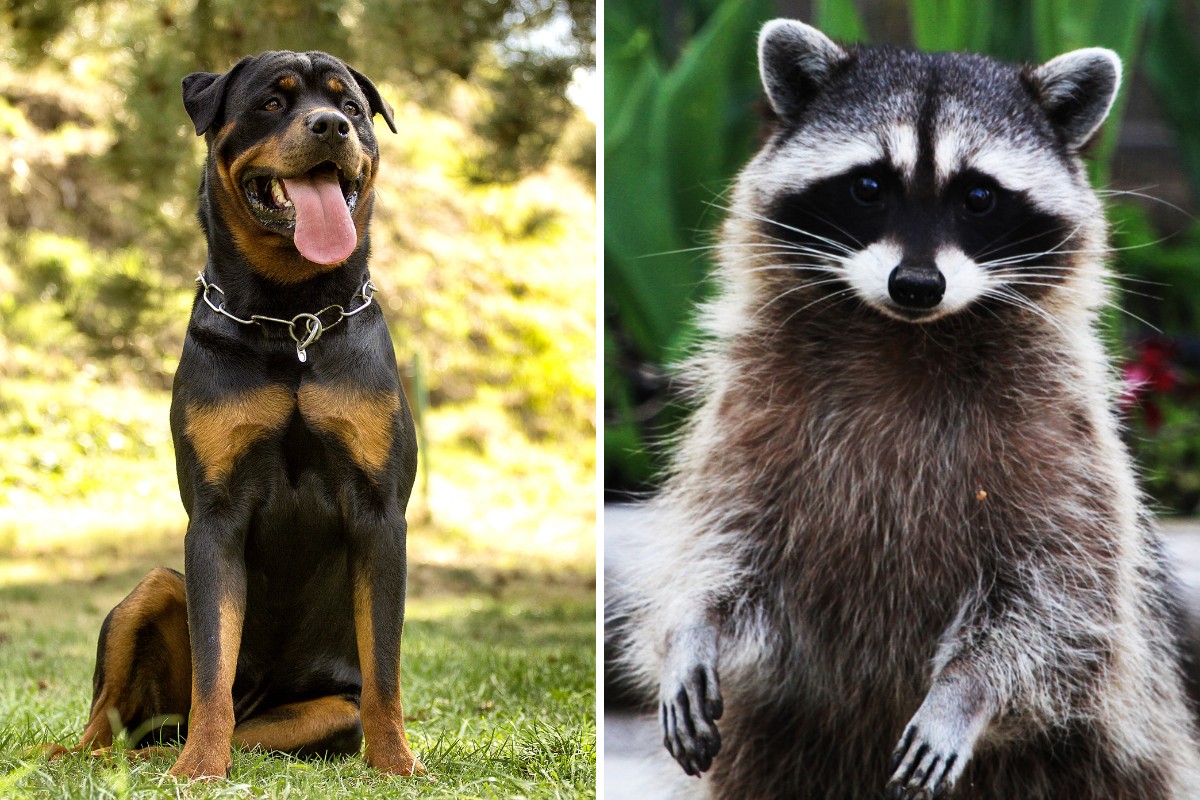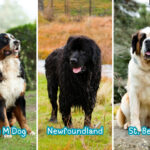 8 Nov
8 NovCan A Rottweiler Kill A Raccoon?
Imagine a crisp evening in your backyard. The sun has just tucked itself below the horizon, and there’s a gentle rustle at the edge of the trees. It’s not just the autumn leaves—it’s a masked visitor, a common raccoon, emerging in search of treats. On the other side of the yard, ears perked, stands your Rottweiler, eyes locked on this unexpected guest. This scene sets the stage for a natural question many dog owners might ask: Can a Rottweiler kill a raccoon?
Yes, a Rottweiler has the physical capability to kill a raccoon due to its size, strength, and natural predatory instincts. However, such interactions between a domestic dog and wildlife can pose significant risks to both animals and are not recommended.
Responsible pet ownership and preventative measures should be in place to avoid these dangerous encounters. It’s important to ensure Rottweilers are supervised when outdoors, properly trained, and socialized to minimize aggressive tendencies towards small animals, including raccoons.
As a devoted dog parent with a soft spot for our four-legged companions, I’ve always been fascinated by the instincts that drive their behaviors, especially those as robust and dignified as the Rottweiler. It’s essential to understand these instincts for their safety and that of the wildlife they may encounter.
Through this post, we’ll explore the capability of Rottweilers to engage with wildlife, specifically raccoons, and the dynamics of such potential encounters.
This isn’t just a matter of who would win in a tussle between a Rottweiler and a raccoon, but it’s about comprehending the depth of a dog’s hunting instinct, the unpredictability of wildlife, and how we as owners can manage these situations responsibly.
After all, awareness is the first step to prevention. So, let’s explore together the realities of canine behavior, their interactions with raccoons, and how we can foster an environment of respect and safety for all.

Understanding Rottweilers
History and Origins of Rottweilers
Rottweilers hail from the small town of Rottweil in Germany, where they were originally bred to drive cattle to market and pull carts for butchers in the Middle Ages. Their lineage is believed to be linked to the Roman drover dogs, sturdy and reliable canines used by Roman legions to herd livestock.
Over time, these robust dogs were recognized not only for their strength but also for their versatility, serving as one of the earliest police dogs and excelling in roles that required resilience, intelligence, and tenacity.
Physical Attributes That Contribute to Their Strength
The Rottweiler is a powerhouse of a breed, characterized by a muscular and athletic build. Typically weighing between 75 to 130 pounds, they possess a broad chest and a well-developed muscular body that exudes strength and endurance.
Their jaws are strong, with a bite force that is formidable and effective for holding and carrying heavy objects, which was essential in their historical roles. These physical attributes contribute significantly to their capabilities as both work dogs and, if the situation arises, formidable opponents for animals like raccoons.
The Prey Drive in Rottweilers
Prey drive is an instinctual behavior pattern that is evident in many dog breeds, including Rottweilers. This drive is what compels them to chase and capture prey. For Rottweilers, the prey drive can manifest as a strong inclination to chase after small, fast-moving animals. While this trait was valuable in their historical working roles, in a modern context, it necessitates that Rottweiler owners understand and manage their dog’s impulses through training and environmental management to prevent any unwarranted behavior.
Rottweiler Temperament and Training
Despite their formidable appearance and history as working dogs, Rottweilers are known for being loyal, confident, and eager to please their owners, making them highly trainable. They thrive on consistency and clear guidance and respond well to positive reinforcement techniques.
Early socialization and regular training are critical in shaping a well-adjusted Rottweiler that can discern between normal and abnormal situations, including encounters with wildlife. Proper training helps mitigate their prey drive and ensures they can be controlled in the presence of small animals, such as raccoons. With a committed owner, Rottweilers can be gentle giants and dependable companions, well-adjusted to a variety of living situations.
Overview Of Raccoons
General Characteristics of Raccoons
Raccoons are small to medium-sized mammals, easily recognizable by their distinctive black mask and ringed tail. They typically weigh between 10 to 30 pounds, with a body adapted to an omnivorous diet; they have nimble front paws and a heightened sense of touch that allows them to forage efficiently.
Raccoons are intelligent, with a remarkable ability to remember tasks and solve problems, which helps them adapt to a wide range of environments, from rural areas to urban settings.
Raccoon Behavior and Natural Defense
Raccoons are primarily nocturnal and known for their curious and opportunistic nature. They can become quite bold in urban areas, scavenging through trash cans and even entering homes in search of food. When threatened, raccoons will usually flee rather than confront their aggressor.
However, if cornered, they can become aggressive, using their sharp teeth and claws as natural defenses. Raccoons are also known carriers of various diseases, such as rabies and canine distemper, which they can transmit to pets and humans through bites or scratches.
The Raccoon’s Role in the Ecosystem
Raccoons play a significant role in their ecosystems. As omnivores, they help control populations of various insects and rodents, contributing to the balance of those species. Their foraging habits also result in the dispersal of seeds, which aids in plant propagation.
Furthermore, in their search for food, raccoons aerate soils and water sources, which can be beneficial for other plant and animal species. Despite sometimes being viewed as pests, especially in urban areas, raccoons are an important part of local biodiversity and contribute to the health of the environments they inhabit.

Factors That Influence The Predatory Encounter
Size and Strength Comparison
In a hypothetical encounter between a Rottweiler and a raccoon, the size and strength advantage leans heavily towards the Rottweiler. Rottweilers are considerably larger and more powerful than raccoons, with the physical capacity to inflict serious harm on the smaller animal.
Rottweilers have a strong, muscular build, powerful jaws, and a significant weight advantage. In contrast, raccoons, while nimble and capable of defending themselves with sharp claws and teeth, are not built to take on opponents of the Rottweiler’s size and strength.
Natural Instincts and Behaviors in a Confrontation
The natural instincts of a Rottweiler in a confrontation with perceived prey can trigger a predatory response, including chasing, grabbing, and biting.
This instinct can be potent when a Rottweiler is not properly trained or socialized. Raccoons, on the other hand, will typically attempt to avoid conflict, but when threatened, they can become fiercely defensive, using their agility, teeth, and claws to fight back, aiming for quick escape routes if possible.
Potential Dangers to Both Animals
An encounter between these two animals carries potential dangers for both. For the raccoon, the risk of injury or death is significant due to the Rottweiler’s superior strength. For the Rottweiler, the dangers are not inconsiderable either.
Raccoons are capable of inflicting wounds with their claws and teeth, and there is a risk of disease transmission, such as rabies or bacterial infections, which can have severe health implications for the dog. The physical struggle could also result in unforeseen injuries to the Rottweiler, like sprains, broken bones, or lacerations requiring veterinary attention.
Legal and Ethical Considerations of Such Encounters
Legally, pet owners may be held responsible for their pets’ actions, including any harm they cause to wildlife. In many places, there are laws protecting wildlife, and allowing a pet to attack a raccoon could be considered an offense, leading to fines or other legal repercussions.
Ethically, there’s a duty to protect our pets and local wildlife, which includes preventing such encounters. Responsible pet ownership involves ensuring that pets do not contribute to the suffering or decline of wildlife populations. This includes leash laws, secure enclosures, and training to ensure that natural predatory encounters do not occur, thereby protecting the safety and well-being of all animals involved.




